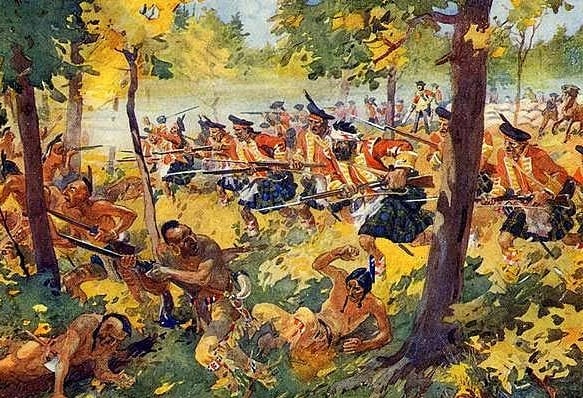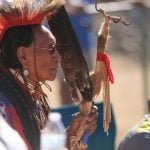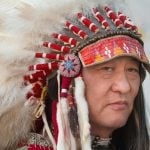Pontiac’s War

In 1763, the Ottawa leader Pontiac led an alliance of Indian nations in the Ohio Valley in a war of resistance against the British. In defeating this Indian alliance, the British turned to biological warfare in the form of smallpox.
Pontiac was probably born about 1720 along the Maumee River in what is now Ohio. His father was Ottawa and his mother was Chippewa (Ojibwa). By 1755 he was recognized by the Ottawa as one of their leaders (i.e. “chiefs”).
Background: Prelude to War
In 1759, a party of Ottawa, Huron, and Potawatomi encountered an English Ranger group in present-day Michigan. The Ottawa leader Pontiac demanded to know why these strangers were trespassing on Indian land. The English told him that they were there only to remove the French. After they gave Pontiac wampum, he smoked with them. While Pontiac agreed to be a subordinate of the English Crown, he told the English that if the King should neglect him, he would shut down all routes to the interior.
The French and Indian War officially ended in 1760 with the defeat of France. As a result, English settlers began to pour across the Alleghenies into Indian territory. While the French had secured the loyalty of their Indian allies by providing them with ammunition and supplies, the English did not. Lord Jeffrey Amherst wrote: “I do not see why the Crown should be put to that expense. Services must be rewarded; it has ever been a maxim with me. But as to purchasing the good behavior either of Indians or any others, [that] is what I do not understand. When men of whatsoever race behave ill, they must be punished but not bribed.”
Indians soon found that they were not welcome at the forts and that intermarriage was discouraged. The English simply assumed that they had no obligation to the original inhabitants of the country and acted accordingly. From an Indian viewpoint, this was not only a breach of protocol, but an open insult to the Indian nations and their leaders. Historians Robert Utley and Wilcomb Washburn, in their book Indian Wars, write: “In sum, the English acted as though they had no obligation toward the inhabitants of the country—with predictable consequences.”
In 1761, the English placed Jeffrey Amherst in charge of Indian relations in the Old Northwest Territory. Amherst felt that presents to the Indians encouraged laziness and that the Indians should support themselves by hunting so that they could obtain the trade goods which they desired. Historian Richard White, in his book The Middle Ground: Indians, Empires, and Republics in the Great Lakes Region, 1650-1815, describes Amherst as having “the moral vision of a shopkeeper and the arrogance of a victorious soldier.”
Lord Jeffrey Amherst, the commander-in-chief of the British forces, suggested to Henry Bouquet, the commander of Fort Pitt: “Could it not be contrived to send the Small Pox among those dissatisfied tribes?” In response Bouquet suggested using infected blankets to distribute the smallpox. He also suggested hunting the Indians with dogs.
In 1762, the Delaware (Lenni Lenape) prophet Neolin had a vision in which he undertook a journey to meet the Master of Life. He was told: “The land on which you are, I have made for you, not for others. Wherefore do you suffer the whites to dwell upon your lands?” “Drive them away; wage war against them; I love them not; they know me not; they are my enemies; they are your brothers’ enemies. Send them back to the land I have made for them.” He received a prayer which is carved in symbolic language on a stick.
After returning from the vision, the prophet drew a map on a deerskin which was used in explaining his vision. This “great book” was sold to followers so that they might refresh their memories from time to time. Neolin’s vision provided the foundation for a pan-Indian movement. One of Neolin’s followers was the Ottawa chief Pontiac. According to ethnologist James Mooney, writing in 1896: “The religious ferment produced by the exhortations of the Delaware prophet spread rapidly from tribe to tribe, until, under the guidance of the master mind of the celebrated chief, Pontiac, it took shape in a grand confederacy of all the northwestern tribes to oppose the further progress of the English.”
Historian Randolph Downes, in his book Council Fires on the Upper Ohio: A Narrative of Indian Affairs in the Upper Ohio Valley until 1795, writes of Neolin’s followers: “They gave up the use of firearms and hunted exclusively with the bow and arrow. They lived entirely on dried meat and a bitter drink whose purgative quality was supposed to rid them of poisons absorbed by years of white contamination.”
While Neolin’s message was anti-European, under Pontiac it became anti-British. Many of Neolin’s followers felt that he was the reincarnation of Winabojo, the great teacher of the mythic past.
The War:
In 1763, Neolin, in present-day Michigan, urged the Three Fires Confederacy—Ottawa, Ojibwa, and Potawatomi,—to expel the British. In response, Pontiac led an alliance of Shawnee, Delaware, and Ojibwa against the British. He told his people: “It is important for us, my brothers, that we exterminate from our land this nation which only seeks to kills us.”
Pontiac and his allies soon seized nine of the eleven British forts in the Ohio Valley. While Pontiac is generally credited with leading the resistance movement, he was actually just one of many Indian leaders who had decided that war with the British was necessary to defend their territory and their way of life.
In response to the Pontiac war and in an attempt to stabilize the volatile situation between settlers and Indians, the British issued the Proclamation of 1763 which forbade European settlement west of the Appalachians. This was, in George Washington’s words, “a temporary expedient to quiet the minds of the Indians.” The Proclamation also removed jurisdiction over Indians from the colonies. Each Indian tribe was regarded as an independent nation and, as such, had to be dealt with by the Crown.
Pontiac’s rebellion was defeated in part because of a smallpox epidemic among the allied tribes. Once again Sir Jeffrey Amherst, Commander of the British forces suggests the use of smallpox as a weapon of war: “You will do well to try to inoculate the Indians by means of blankets, as well as to try every other method that can serve to extirpate this execrable race.”
One officer—Captain Simeon Ecuyer, a Swiss mercenary—reported that during peace negotiations with the Delaware, the Indians were given two blankets and a handkerchief which had been deliberately infected with smallpox spores at the post hospital. Other officers handed out smallpox-infected clothing. The English recorded this transaction in an invoice which stated: “To sundries go to replace in kind those which were taken from the people in the hospital to convey the smallpox to the indians. Viz: 2 Blankets; 1 silk hankerchef and 1 linnen”
Soon smallpox was sweeping through the allied tribes, weakening their ability to wage war. R. G. Robertson in his book, Rotting Face: Smallpox and the American Indian, reports: “By mid July, the Delawares were dying as though they had been raked by a grape cannonade.”
In 1764, Pontiac sent the British a wampum belt for peace. The British simply chopped up the belt. This would be like a European ambassador urinating on a proposed treaty. It was an act which shocked and angered the Indians. The act convinced Pontiac that he had nothing to gain by negotiating with the British.
In the Ohio Valley, the Shawnee, Seneca, and Lenni Lenape joined together to send war belts to the Miami and to Pontiac’s Ottawa asking them to fight the British. These three nations were joined by the Munsee and the Wyandot to form the Five Nations of Scioto.
At the end of the conflict, the British demanded that all European “captives” be returned. About 200 men, women, and children were turned over to the soldiers amid a torrent of tears. According to one military observer: “Every captive left the Indians with regret.” While there were no reports of Indian captives who did not want to return to their own people, it was common for European captives to refuse repatriation.
With regard to the defeat of Pontiac and his allies, Lee Miller, in his book From the Heart: Voices of the American Indian, notes that the “British can congratulate themselves, for they will go down in infamy as the first ‘civilized’ nation to use germ warfare.”
By 1765, the war was over and the British asked Pontiac to carry the message of peace to the other tribes of the Ohio Valley and to serve as an intertribal chief in negotiating peace. As a result the Ottawa, Wyandot, Ojibwa, Miami, Kickapoo, Potawatomi, and Mascouten attended peace conferences.
The Indians felt that the French had simply been tenants on their land and had provided tribute—powder, rum, and other goods—as a type of rent. The British, on the other hand, felt that they themselves were governed by international law and that Indians were not members of the “family of nations”. Therefore, from the British viewpoint, the Indians should have no more rights than the animals they hunted.
In 1767, Pontiac formally signed a peace agreement with the British. Two years later he was killed by Black Dog, a Peoria Indian, following a drunken argument in the establishment of a British trader. Many felt that the British arranged for Pontiac’s assassination because Black Dog was known to be in the pay of the British.



